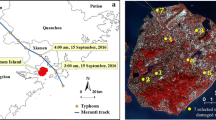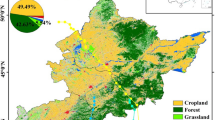Abstract
In the global carbon cycle, terrestrial biomass plays an important role in both as a sink and source. To evaluate biomass variation due to various natural hazards, it is necessary to detect the location, extent and duration of vegetation disturbance at a large spatial scale with an efficient method. This study contributes to develop such a method, and only the moderate resolution imaging spectroradiometer (MODIS) MOD13Q1 enhanced vegetation index (EVI) products are used to generate a continuous vegetation damage index (CVDI) for detecting severe vegetation disturbance in large areas. To verify the performance of this new index, this study takes the identification of the vegetation damage due to the Wenchuan earthquake in China occurred on 12 May 2008 as a case study. This study calculates the CVDI for the earthquake stricken areas, and delineates the regions with considerable EVI abnormal variation. The study result reveals that those delineated regions with severe vegetation damage are normally consistent with the areas with the landslides caused by the earthquake. Moreover, according to the changes of other vegetation-related MODIS datasets since 12 May 2008, this study discloses that the EVI value in most of the areas, where the vegetation was damaged due to the earthquake, has not reached to the normal value in 2012, which is 4 years after the earthquake. Finally, to validate the vegetation damage areas determined by CVDI method, the high resolution images and field survey information are used. This study confirms that CVDI method can effectively delineate large-scale terrestrial biomass disturbance due to the earthquake and can accurately identify the vegetation recovery process.








Similar content being viewed by others
References
Chen J, Sun L (2010) Using MODIS EVI to detect vegetation damage caused by the 2008 ice and snow storms in south China. J Geophys Res 115:G00H04
Cui P, Lin Y, Chen C (2012) Destruction of vegetation due to geo-hazards and its environmental impacts in the Wenchuan earthquake areas. Ecol Eng 44:61–69
Dai FC, Xu C, Yao X, Xu L, Tu XB, Gong QM (2011) Spatial distribution of landslides triggered by the 2008 Ms 8.0 Wenchuan earthquake, China. J Asian Earth Sci 40:883–895
Di Mauro B, Fava F, Busetto L, Crosta GF, Colombo R (2014) Post-fire resilience in the Alpine region estimated from MODIS satellite multispectral data. Int J Appl Earth Obs Geoinform 32:163–172
Di B, Zeng H, Zhang M, Ustin SL, Tang Y, Wang Z, Chen N, Zhang B (2010) Quantifying the spatial distribution of soil mass wasting processes after the 2008 earthquake in Wenchuan, China: a case study of the Longmenshan area. Remote Sens Environ 114:761–771
Gu L, Hanson PJ, Mac Post W, Kaiser DP, Yang B, Nemani R, Pallardy SG, Meyers T (2008) The 2007 eastern US spring freezes: increased cold damage in a warming world? Bioscience 58:253–262
Horion S, Fensholt R, Tagesson T, Ehammer A (2014) Using earth observation-based dry season NDVI trends for assessment of changes in tree cover in the Sahel. Int J Remote Sens 35:2493–2515
Huang RQ, Li WL (2009) Analysis of the geo-hazards triggered by the 12 May 2008 Wenchuan earthquake, China. Bull Eng Geol Environ 68:363–371
Huete A, Justice C, Liu H (1994) Development of vegetation and soil indices for MODIS-EOS. Remote Sens Environ 49:224–234
Huete A, Didan K, Miura T, Rodriguez EP, Gao X, Ferreira LG (2002) Overview of the radiometric and biophysical performance of the MODIS vegetation indices. Remote Sens Environ 83:195–213
Kamat R (2015) Planning and managing earthquake and flood prone towns. Stoch Environ Res Risk Assess 29:527–545
Kim Y, Kimball JS, Didan K, Henebry GM (2014) Response of vegetation growth and productivity to spring climate indicators in the conterminous United States derived from satellite remote sensing data fusion. Agric For Meteorol 194:132–143
King DJ, Olthof I, Pellikka PKE, Seed ED, Butson C (2005) Modelling and mapping damage to forests from an ice storm using remote sensing and environmental data. Nat Hazards 35:321–342
Lam NSN, Liu KB, Liang W, Bianchette TA, Platt WJ (2011) Effects of hurricanes on the Gulf Coast ecosystems: a remote sensing study of land cover change around Weeks Bay, Alabama. J Coast Res 64:1707–1711
Li TJ, Wang GQ, Huang YF, Fu XD (2009) Modeling the process of Hillslope soil erosion in the Loess Plateau. J Environ Inform 14:1–10
Liu F, Li J, Yang S (2015) Landslide erosion associated with the Wenchuan earthquake in the Minjiang River watershed: implication for landscape evolution of the Longmen Shan, eastern Tibetan Plateau. Nat Hazards 76:1911–1926
Lu T, Zeng H, Luo Y, Wang Q, Shi F, Sun G, Wu Y, Wu N (2012) Monitoring vegetation recovery after China’s May 2008 Wenchuan earthquake using Landsat TM time-series data: a case study in Mao County. Ecol Res 27:955–966
Mildrexler DJ, Zhao M, Running SW (2009) Testing a MODIS global disturbance index across North America. Remote Sens Environ 113:2103–2117
Neigh CSR, Bolton DK, Williams JJ, Diabate M (2014) Evaluating an automated approach for monitoring forest disturbances in the Pacific Northwest from logging, fire and insect outbreaks with Landsat time series data. Forests 5:3169–3198
Parsons T, Ji C, Kirby E (2008) Stress changes from the 2008 Wenchuan earthquake and increased hazard in the Sichuan basin. Nature 454:509–510
Powell SJ, Jakeman A, Croke B (2014) Can NDVI response indicate the effective flood extent in macrophyte dominated floodplain wetlands? Ecol Indic 45:486–493
Rigby JR, Porporato A (2008) Spring frost risk in a changing climate. Geophys Res Lett 35:L12703
Running SW (2008) Climate change: ecosystem disturbance, carbon, and climate. Science 321:652–653
Sivakumar B, Christakos G (2011) Climate: patterns, changes, and impacts. Stoch Environ Res Risk Assess 25:443–444
Stueve KM, Lafon CW, Isaacs RE (2007) Spatial patterns of ice storm disturbance on a forested landscape in the Appalachian Mountains, Virginia. Area 39:20–30
Sun Y, Gu L, Dickinson RE, Zhou B (2012) Forest greenness after the massive 2008 Chinese ice storm: integrated effects of natural processes and human intervention. Environ Res Lett 7:035702
Tang C, Zhu J, Qi X, Ding J (2011) Landslides induced by the Wenchuan earthquake and the subsequent strong rainfall event: a case study in the Beichuan area of China. Eng Geol 122:22–33
Vicente-Serrano SM, Gouveia C, Julio Camarero J, Begueria S, Trigo R, Lopez-Moreno JI, Azorin-Molina C, Pasho E, Lorenzo-Lacruz J, Revuelto J, Moran-Tejeda E, Sanchez-Lorenzo A (2013) Response of vegetation to drought time-scales across global land biomes. Proc Natl Acad Sci USA 110:52–57
Vlassova L, Perez-Cabello F, Rodrigues Mimbrero M, Montorio Lloveria R, Garcia-Martin A (2014) Analysis of the relationship between land surface temperature and wildfire severity in a series of Landsat images. Remote Sensing 6:6136–6162
Wan ZM (2008) New refinements and validation of the MODIS land-surface temperature/emissivity products. Remote Sens Environ 112:59–74
Wang M, Yang W, Shi P, Xu C, Liu L (2014) Diagnosis of vegetation recovery in mountainous regions after the Wenchuan earthquake. IEEE J Sel Top Appl Earth Obs Remote Sens 7:3029–3037
Wu F, Yu B, Yan M, Wang Z (2010) Eco-environmental research on the Wenchuan earthquake area using disaster monitoring constellation (DMC) Beijing-1 small satellite images. Int J Remote Sens 31:3643–3660
Wu Y, Li T, Sun L, Chen J (2013) Parallelization of a hydrological model using the message passing interface. Environ Model Softw 43:124–132
Xu C, Xu XW, Yao X, Dai FC (2014) Three (nearly) complete inventories of landslides triggered by the May 12, 2008 Wenchuan Mw 7.9 earthquake of China and their spatial distribution statistical analysis. Landslides 11:441–461
Yang X, Chen L (2010) Using multi-temporal remote sensor imagery to detect earthquake-triggered landslides. Int J Appl Earth Obs Geoinform 12:487–495
Yang C, Ren X, Huang H (2012) The vegetation damage assessment of the Wenchuan earthquake of May 2008 using remote sensing and GIS. Nat Hazards 62:45–55
Yang W, Wang M, Shi P (2013) Using MODIS NDVI time series to identify geographic patterns of landslides in vegetated regions. IEEE Geosci Remote Sens Lett 10:707–710
Zhang WJ, Wang HM, Yang FT, Yi YH, Wen XF, Sun XM, Yu GR, Wang YD, Ning JC (2011) Underestimated effects of low temperature during early growing season on carbon sequestration of a subtropical coniferous plantation. Biogeosciences 8:1667–1678
Acknowledgments
We are grateful to the anonymous reviewers who offered insightful comments that led to improvements of this paper. The study is financially support by one General Research Fund (GRF) Project (No.: HKU 710712E) from the Research Grants Council of Hong Kong and a NSFC Project (No.: 51479224).
Author information
Authors and Affiliations
Corresponding author
Rights and permissions
About this article
Cite this article
Sun, L., Chen, J. & Li, T. A MODIS-based method for detecting large-scale vegetation disturbance due to natural hazards: a case study of Wenchuan earthquake stricken regions in China. Stoch Environ Res Risk Assess 30, 2243–2254 (2016). https://doi.org/10.1007/s00477-015-1160-z
Published:
Issue Date:
DOI: https://doi.org/10.1007/s00477-015-1160-z




